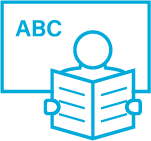GraphoLearn India: The Effectiveness of a Computer-Assisted Reading Intervention in Supporting Struggling Readers of English
The aim of this study was to determine whether GraphoLearn, a computer-assisted reading tool, could be used to support the English reading skills of struggling readers in India. GraphoLearn led to significant improvements in children’s letter-sound knowledge. Thus, it offers a potential intervention to support struggling readers of English in India.
Authors: Priyanka Patel, Minna Torppa, Mikko Aro, Ulla Richardson, & Heikki Lyytinen
Source: Patel, P., Torppa, M., Aro, M., Richardson, U., and Lyytinen, H. (2018). GraphoLearn India: The Effectiveness of a Computer-Assisted Reading Intervention in Supporting Struggling Readers of English. Front. Psychol. 9:1045. doi: 10.3389/fpsyg.2018.01045
There are hundreds of millions of illiterate individuals in India. Those living in poverty struggle to learn English as they have no prior exposure to it and no support at home. The aim of this study was to determine whether GraphoLearn, a computer-assisted reading tool, could be used to support the English reading skills of struggling readers in India. Participants were 7-year-old, Grade 3 students (N = 30) who were not native English speakers. Grapholearn led to significant improvements in children’s letter-sound knowledge. Thus, it was determined that GraphoLearn offers a potential intervention to support struggling readers of English in India.
- The population of India is over 1.3 billion, and the literacy rate is 72% among those aged 15 years or older.
- Education plays a major role in literacy; however, those living in poverty face many problems in accessing education.
- With a country-wide push towards English-medium education in India, poor students especially are studying in a language that they may have no prior exposure to and no support at home for.
- Speaking English can influence the standard of living in India, as those with better English skills attain better job opportunities and consequently better pay.
- Slum children often have no exposure to English prior to entering school, as parents typically cannot speak English and are also illiterate in their mother tongue.
Schooling in India
- A large majority (95.9%) of children ages 6–14 years are enrolled in school across India.
- Across all languages, only 47.8% of children in Grade 5 are able to read a Grade 2 level text.
- In term of English, only 19.3% of Grade 3 children can read simple words.
What is GraphoLearn?
- This was previously known as GraphoGame.
- It is a theoretically-driven, computer-assisted tool for early reading that provides training on the connections between spoken and written language by explicitly instructing on grapheme–phoneme correspondences.
Grapheme–Phoneme correspondences
- Those learning to read need to understand the grapheme–phoneme correspondences that occur within a particular language.
- Knowledge of grapheme–phoneme correspondences directly impacts reading fluency.
- Ease of reading acquisition is greatly determined by the orthographic depth of a language.
- The grapheme–phoneme correspondences in English are more complex and context-dependent.
- English (and other opaque orthographies) might be more effectively introduced through larger units, also known as rime units, rather than at the level of single graphemes and phonemes, although this idea is subject to disagreement.
- There tends to be consensus that early reading instruction through phonics should follow a systematic approach whereby children are taught to connect spoken language segments to their corresponding written forms.
Methods of Teaching English
Rote manner
- Children in India are taught English in rote manner.
- Students learn the names of letters, rather than sounds, and are then expected to learn ‘common’ words as a whole.
- Through such rote learning methods, children are unable to blend or decode unfamiliar words and are therefore only able to ‘read’ words that are familiar to them.
Systematic phonics
- This refers to explicitly instructing readers on the linkages that exist between letters and their corresponding sounds and how that is then used to read words.
- This approach is believed to be the most logical way to support early reading development.
The study
This study examined the efficacy of GraphoLearn, a computer-assisted reading tool, in improving basic English reading skills of slum children in India by supporting the development of grapheme–phoneme knowledge, reading, and spelling ability.
Participants were 31 Grade 3 learners, aged 7–8 years. Students were randomly allocated to either the experimental group (which played GraphoLearn; n = 16) or the control group, which played a math game (n = 15). All students came from low-income homes with no exposure to English in the home environment. One student’s data was removed because they did not participate in any of the post-tests.
Findings
- At post-test, group differences in favour of the GraphoLearn group were significant for all GraphoLearn tasks (letter-sounds, rime units, and word recognition).
- On the paper-and-pencil tasks, results revealed no significant differences between groups at either pre-test or post-test.
- For both GraphoLearn and paper-and-pencil tasks, there was a significant main effect of time on all three tasks (letter-sounds, rime units, and word recognition), with both groups showing improvement from pre- to post-test.
- For the letter-sounds task, there was a significant main effect for group and a significant interaction effect for time*group, with the GraphoLearn group showing significantly higher scores and faster development than the control group.
Implications
- The GraphoLearn intervention group showed the greatest improvements with the letter-sounds task; therefore, it can effectively support the development of English letter-sound knowledge among Indian children.
- Letter-sound knowledge has been identified as a critical building block in early reading development and it affects early literacy skills.
- Technology has the potential to enhance learning.
- The greatest efficiency may be achieved if technology is used to create a ‘blended learning’ environment in which teachers use information gathered from the technology to guide further instruction.



